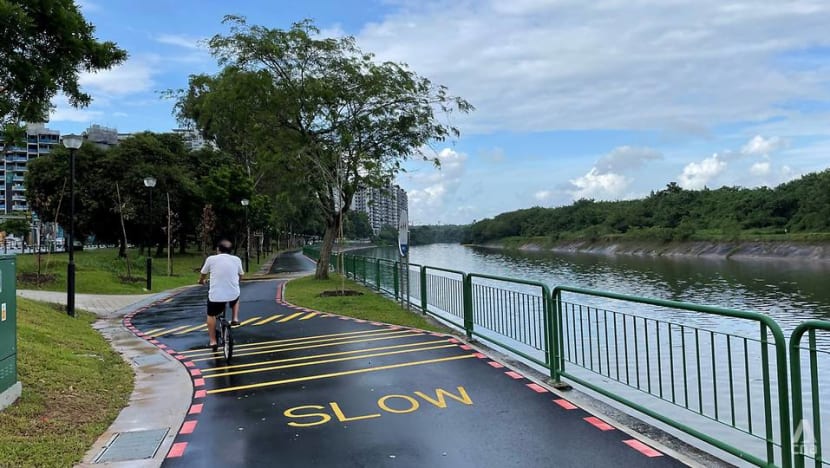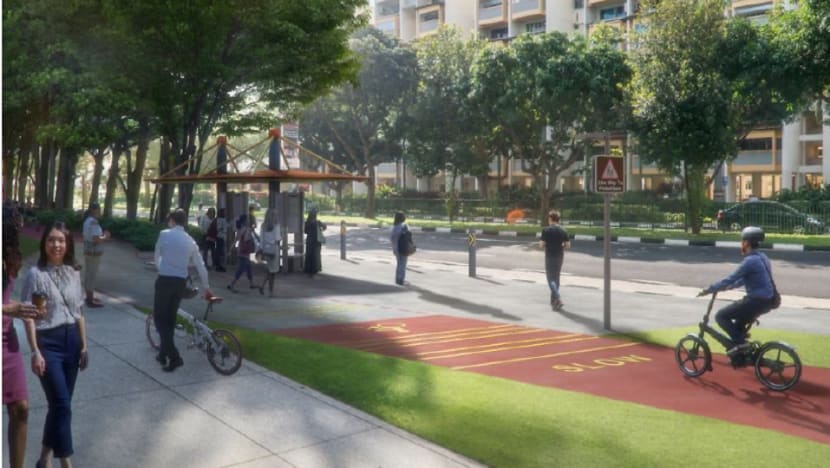commentary Commentary
Commentary: Banning bicycles from footpaths won’t make poor cycling habits disappear
Calls to ban bikes from footpaths in response to new brake requirements may have grown from Singapore’s poor experience with shared bikes and PMDs. But it’s worth taking a step back to embrace a middle-ground approach benefitting both cyclists and pedestrians.

File photo of a man cycling along a park connector in Singapore.
SINGAPORE: For anyone who has had a close shave with a cyclist who may have been pedaling just a little too fast, the natural instinct might be to wish pedestrians never have to face such situations.
Many unfortunate, avoidable accidents over the last two years have underscored how dangerous bicycles can be in crowded neigbourhoods teeming with young children, families and senior citizens.
If cyclists don’t know any better than to go at top speeds, then harsh action must be taken.
Indeed, that might have been the initial thought coursing through the minds of many netizens after news the Government would accept recommendations to impose new cycling brake requirements on Jan 25.
Comments online calling for a ban altogether on bicycles mushroomed. Ban bicycles from pedestrian walkways, many said. But ban bicycles from roads too, others added.
READ: IN FOCUS: Why can't cyclists and motorists just get along?
THE POOR EXPERIENCE WITH THE PMD BAN
It’s only been just over a year since Singapore took the approach to ban the use of personal mobility devices (PMDs) from footpaths to tackle the growing number of accidents.
Yet, memory of the ensuing chaos should serve as a cautionary tale against calls for a wholesale or even partial ban of bicycles.
The announcement came as a surprise when then Senior Minister of State for Transport Janil Puthucheary had cautioned mere weeks before against a knee-jerk reaction to a small number of people behaving badly and said that a ban on PMDs was not immediately necessary.
When the ban was announced, pedestrians gave the thumbs up. But many responsible users who had diligently followed the increasingly tightened set of rules on PMD use and invested quite a bit of money were frustrated by the move.
READ: Commentary: The year e-scooters were kicked off footpaths
It was unclear whether authorities had factored in the potential impact on the livelihoods of PMD retailers and food deliverers, whose earnings took a hit. A swift remedial policy taking the form of a S$7 million trade-in grant may have helped some make the painful adjustment to approved devices.
Age restrictions on e-scooter use and a requirement to pass a theory test were subsequently passed in December 2019.
The moves taken together were intended to calibrate the use of PMDs in Singapore, given the ongoing recklessness of a visible minority that caused public alarm, Singapore University of Social Sciences’ Associate Professor Walter Theseira had said while on CNA’s Heart of the Matter podcast shortly after.

“The situation was getting critical … if we let (the situation) roll on for another six months, what if another major accident happened?” Vice-President (Safety/Education) of Singapore Cycling Federation Steven Lim who was also on the podcast highlighted when asked whether if a ban could have been considered only after the age restrictions and test requirements kicked in.
But the heated Meet-the-People sessions and misgivings voiced in Parliament suggest room for improvement on the approach to dealing with errant PMD users away from resorting to the blunt sledgehammer of banning PMDs from footpaths altogether.
READ: Commentary: What’s next for e-scooters after the footpath ban?
READ: IN FOCUS: The PMD footpath ban a year on - what has changed?
THE SHARED BIKES EXPERIMENT
Could netizens’ latest calls to ban bicycles have been informed by Singapore’s unforgettable roller-coaster relationship with shared bikes?
The approach had erred on the other end of the spectrum in avoiding over-regulating and stymying free enterprise.
In hindsight, shared bikes seemed to have received some level of unwarranted special dispensation from a country that otherwise typically prized order and neatness above all.
Authorities had taken a light-touch approach, perhaps believing the power of markets could be harnessed, even tamed, to catalyse a culture of cycling in line with Singapore’s national active mobility goals.
If bike-sharing firms were given latitude to scale up, and enforcement carried the policy when operators crossed certain lines, surely this private-public partnership could accelerate the Land Transport Authority’s 2013 goal of equipping all 26 HDB towns with a comprehensive cycling network, the thinking must have gone.
READ: Commentary: Cycling great for going green but is still a pain in urban Singapore

A Memorandum of Understanding was signed in 2017 among authorities and bike-sharing operators, outlining explicitly the contours of this compact.
But as strewn bikes started to dot the urban landscape, it became clear requirements for operators to remove indiscriminately parked bikes and install geofencing tech could not fix poor corporate management or overcome overhyped but problematic business models.
READ: Commentary: The curious case of slick start-ups that tout billion-dollar valuations then rapidly collapse
By 2018, Mobike, ofo and oBike eventually called it a day. But cleaning up Singapore streets long after those firms raised the white flag was a painful exercise. The sight also left a poor taste in the mouths of many Singaporeans.
THE MIDDLE GROUND
To be sure, Singapore’s approach towards public cycling has come far since those days.
Laws have been strengthened against bad behaviour. Footpath speed limits and restrictions on bicycle size have been in place to ensure bicycles do not pose an undue danger to pedestrians.
Penalties on reckless riding have been raised to a fine of up to S$10,000 or jail for 12 months, with offenders potentially charged under the Penal Code for causing hurt, Transport Minister Ong Ye Kung pointed out in Parliament last October.

The cycling infrastructure has improved. Extensions to the national park connector network along Lornie and from East Coast to Changi Airport just completed in end-2020.
There are also plans in the pipeline taking onboard public feedback for cycling to be factored into urban planning. A new Tengah Park District will be designed to be car-free and more friendly towards cyclists and pedestrians.
Cycling enthusiasts can look forward to a S$1 billion expansion of cycling paths to 1,320km by 2030.
Neighbourhoods will also benefit from the increased pedestrianisation of roads, like that of Woodlands Ring Road, adjacent to Kampung Admiralty and frequently used by Sembawang and Woodlands residents, announced by the Land Transport Authority in January.
These moves to create more space for both pedestrians and cyclists could reduce friction and the risk of future accidents.
READ: Commentary: Is it time to give public bike-sharing a shot?
Mindsets are also evolving, with the Code of Conduct on cycling in public areas introduced in 2018 encouraging cyclists and pedestrians to play their part in contributing to a gracious active mobility culture.
Authorities allowing stickers on a beloved Tuas lamp post earlier this month was a welcomed recognition of just how much cycling has grown to become a treasured national pastime to be gingerly safeguarded.

THINK TWICE BEFORE CALLING FOR A BAN
There are early signs the needle has moved on our cycling safety culture with this more nuanced middle ground approach - thanks in part to the needed passage of time for regulatory and infrastructural issues to be ironed out, and in part due to Singapore’s traumatic experience with shared bikes and PMDs reminding cyclists to pay careful attention while out and about.
Accidents involving cyclists and e-bikes have reduced from 2018 to 2018 by more than 10 per cent.
SG Bike, one of the few remaining shared bike operators, has plans to increase its fleet size to 100,000 by 2023 after seeing a sustained uptick for many months in 2020.
Seen in this light, the recommendations by the Active Mobility Advisory Panel endorsed by the Government on Monday for bikes to have brakes may be striking a good balance between ensuring the safety of pedestrians while not placing unduly stringent curbs on cyclists.
Still, this doesn’t negate the need for cyclists to exercise caution so everyone can enjoy being out and about without worrying about an accident.
READ: Commentary: What happened to caution and graciousness on the roads?
Let’s not forget these rules were suggested because of poor cycling habits. Reckless, aggressive cycling that puts people at risk must be reined in.
To be sure, online debate on regulating cycling and other areas of public policy can serve as a compelling catalyst for big, progressive shifts and meaningful changes.
But where Singaporeans have implored leaders to be responsive to public opinion, netizens must also recognise the responsibility that comes with urging national leaders to take tough action in response to social ills - like banning bicycles from footpaths or roads.
Listen to experts debate the PMD ban on CNA's Heart of the Matter published in December 2019:
Lin Suling is executive editor at CNA Digital News where she oversees the Commentary section and hosts the Heart of the Matter podcast.














